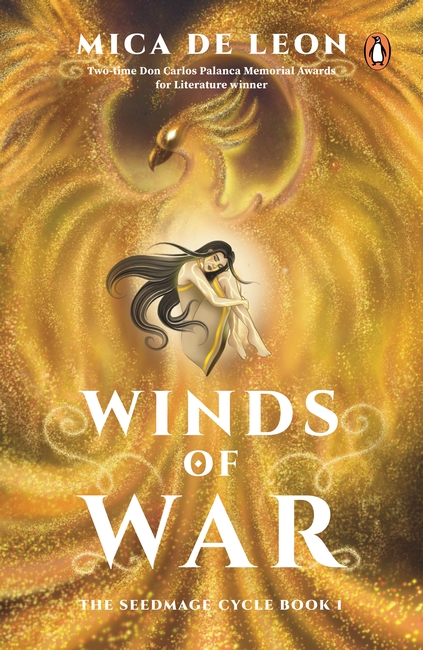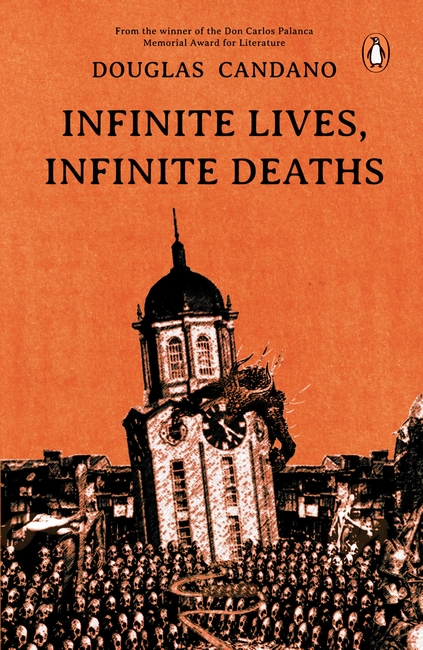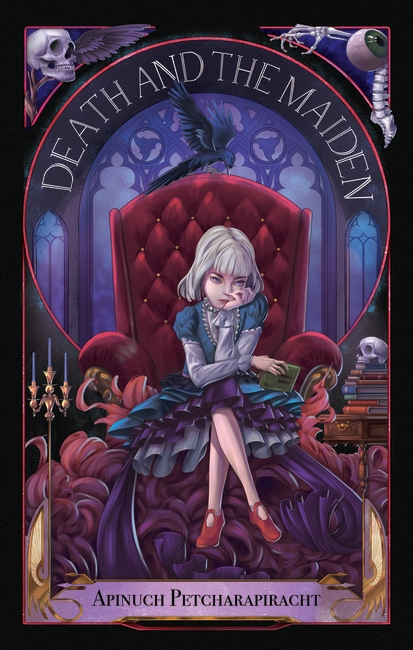
The lost gods of Kayumalon are returning.
Before the exodus of kings to Kayumalon, seed mages were revered by both strangelords and mortal men, their magic reserved only for the bloodlines the gods deem worthy. It was a time of peace and prosperity, but it was an age that had passed on into history and then myth and then superstitious whispers around the bonfire.
Now, seed magic is cheap, the power of the gods reduced to a bottle of oil and borrowed magic mass-produced on magic plantations and coveted by enemies within and without.
Little do they know that Kayumalon’s fate will fall in the hands of a simple Dayo slave girl.
Yin knows that Masalanta Island Plantation is not home—though she longs to become a part of it, if only to be noticed by the island’s most beautiful red-haired boy. All she knows is that she and her father have been on the run all her life, and no matter how many times she asks her father why, he would only warn her that the world means her harm.
When the boy does notice her, she follows him into the night against her better judgement and realizes too late that her father is right. She wakes up the next day, feeling like she had the world in the palm of her hands and power that any girl in her position could only dream about.

Infinite Lives, Infinite Deaths is a collection of stories that straddle genres such as horror, magic realism, metafiction, and science fiction, while stitching together elements from world mythology and folklore, Philippine history and society, and the Chinese-Filipino experience in a nightmarish version of Manila.
In Dreaming Valhalla, a family’s noodle restaurant is converted into a Norse-themed girly bar that parallels the rise and destruction of the Æsir. A group of children take a traumatic fieldtrip in A Visit to the Exhibition of the International Committee on Children’s Rights. In An Epistle and Testimony from June 13, 1604 a Spanish friar meets a Chinese convert bearing the stigmata, while in The Life and Death of Hermes Uy, a Chinese-Filipino entrepreneur opens a pharmacy in 1950s Manila, diversifying and expanding the business throughout the decades until its mysterious and abrupt closure.
A professor of applied folkloristics discusses the case of a young girl who returned home as a crone a few days after her elopement in A Reply to a Query, while Where Old Whores Go to Die features a grant application assessment detailing the context and procedures that govern a concentration camp for aged prostitutes. In The Way of Those Who Stayed Behind a Chinese-Filipino expatriate returns home and uncovers a family secret, while The Lament of Philip Reyes features a failed doctor coming face-to-face with the possibilities that never materialized throughout his life.

Lucky Lee has everything—wealth, charm, money, good looks—and does very, very little with it. He’s content. He’s happy. He takes for granted that life is good and always will be. But then his sister, the go-getting, successful, famous TV chef Pearl Lee, dies, horribly, and suddenly. Lucky is devastated. As he struggles to live without the big sister who’s always been the dominant, often relentless force in his life, the inconceivable happens—her cat begins to talk to him. It wants to know where Pearl is. It questions his eating habits, his outfit choices, his life. It hogs the TV. It tells him stories. Now grief-stricken Lucky has a major problem: he may very well be mad.

Chang Hong Lian, dubbed Red Lotus, is found dead in the lake at the Taiping Botanical Garden. Murdered with a borrowed knife, the plot is coincidentally similar to Adrian Holmes’ bestseller—a crime thriller ghostwritten by Hong Lian’s twin and Adrian’s mistress, Chang Pai Lian (aka White Lotus). The body of Red Lotus, who was with child, was found with the rare South Sea pearl necklace that belongs to Adrian’s wife, Marguerite Daisy Holmes.
Ernest Maxwell Graves, a writer of sorts, comes from a literary lineage. With his latest novel adding to the list of his failures, all he can do is end his life to end the shame. But fate has other plans for him. Saved by a ghost, Graves is promised success. He just doesn’t know yet the price he’ll be paying for it.
White Lotus, who was madly in love with Adrian, committed suicide under the bridge at the Taiping Botanical Garden where her sister’s body was found. She is back, still head over heels in love, and has a story to tell . . .
A murder mystery meets horror fantasy, this compelling tale of love and redemption will send a chill down your spine with every twist and turn.

Harmony Heights is anything but harmonious. In this nineties-style block of condominium located in a forgotten part of town resides a microcosm of bourgeois Malaysian society. From retired judges and doctors to CEOs and homemakers with side hustles, the residents in this apartment pride themselves on being model citizens.
But beneath the veneer of civility and respectability, lies a hotbed of secrets and skeletons that reveal the true nature of these residents. How will they respond to the trials and tribulations which life throws at them? Will they all manage to keep up appearances when their private affairs and exploits are exposed?
Harmony Heights is a peephole, allowing you to look in, to watch the unfolding lives of cheating husbands, ambitious women, unconventional families, and witness explosive (literally) situations. If you look close enough, you might just see someone you know. Are you ready to keep a secret?

In the terrain of untidy relationships lies an ensemble of individuals coupled or alone, each driven by desire, cravings or folly. How To Hunger is a smorgasbord of short stories about how humans hunger—for love, lust and loyalty—where their voracity for the ordinary and sublime consumes them to the very end.
A Singapore emigrant chews over her sense of belonging. A vegetarian Western tourist finds a meatier version of Asia in a massage parlour. A young couple deepens their romance through home-cooked cuisine. A friendship between a Taiwanese and Singaporean ages over a decade like fine wine. An office worker’s submerged desires bubbles over in a hotpot restaurant. A married woman is tempted
by the sweet gifts of a suitor. An undertaker gets a taste of a spicy side of life. And a widower gets triggered by the scent of a curry puff.

This volume consists of a critical introduction and translations of nine short stories on animals by prominent Vietnamese writers from the French colonial period (1885-1945) to the present-day. These stories have been in active circulation and have been highly regarded in literary circles in Vietnam since 1986, the ‘Year of the Reform’, when Vietnamese literary works were politically and culturally ‘liberated’ and engaged with greater commitment to criticizing, among other things, mainstream ideologies. Specifically, since the inception of ecocritical awareness in Vietnam from the start of the 21st Century, there has been an intellectual movement that has explored and recovered Vietnamese environmental, animal and climate crisis stories since medieval times. These are valued as voices that challenge and counter mainstream socialist ideology that overlooks the survival and lives of marginalized beings, including ethnic minorities and non-human nature. The authors have carefully selected the best animal stories that have been identified as the most influential in Vietnamese literature, which are deserving of global recognition. They have been chosen from various short story collections and literary textbooks—prescribed in schools and colleges—in Vietnam. The critical introduction begins by sketching the field of Animal Studies drawing upon various contemporary theoretical perspectives. It then goes on to examine the historical origins and formulations of animal stories in Vietnam. This section carefully traces the symbolic significance of animals in Vietnamese cultural imaginary. The ensuing section discusses the impact of ecocriticism and contemporary status of Animal Studies in Vietnam. The final section provides critical insights on the stories in the collection.

Who wouldn’t cry when they realize that they are dead?
The capital beyond twilight is full of nocturnal birds squealing annoyingly on electricity poles. Who would have known that they were messengers of death who perform music to send souls to the underworld?
Stella is a ghost boy in a skirt who lives in an abandoned tower in the middle of the capital. He calls himself the Eleventh Floor Theater Administrator. Every evening he wakes up to repeat the same routine, caring for lost children, watching a spectacular parade of the Defeated Gamblers. The boy wonders why the Reaper whom he lived with had not yet sent his soul away.
What secrets are the Reaper keeping from him? And what is he being protected from?

Bryce and Nora fall in love in their last year of high school. They worry about their relationship surviving after graduation but are separated sooner when Bryce’s father is transferred and Bryce has to leave.
Bryce promises to write but not in a conventional way. He promises to leave messages behind pictures in hotels where his father works. He tells Nora if she finds his messages, they are meant to be together.
Years pass and Bryce leaves messages for Nora as promised, but wonders if it may be more of a habit than anything else.
Bryce and Nora have moved on to other partners over the years and while Bryce still leaves messages for Nora, she has mostly forgotten his promise until she finds an old photo of Bryce. She begins to search for his messages and succeeds in finding one.
This action is enough for fate to trigger a series of serendipitous events that will bring Bryce and Nora together again but at what cost and who will pay the price?

Room 216 is about four strong female characters and their complex experiences. It tells the story of university roommates, each with a unique motivation and struggle. After graduation, Sandy, Tintin, Serene, and Issa embark on separate journeys that take each to different parts of the world. Following several relocations, Tintin now lives in America, ten thousand miles away from her ancestral home in the Philippines, but one that she keeps revisiting because it houses all her memories and has been the only permanent home she’s known. But her mother and sister now want to put the property for sale. Sandy, now based in Singapore, is an achiever who wants both career and family, but soon faces a marital crisis that may also threaten her most important role: being a mother. Serene is a doctor in Manila who realizes how life, in its real essence, is truly short. This awareness emboldens her to follow her heart, even if it means shunning her traditional Chinese family. Issa is simply stunning. She loves every inch of her beautiful body for the strength it gives her and for making her capable. But she is diagnosed with a disease that requires surgery and she must now come to terms with the attendant scar and the sense of incompleteness.
Over time and across continents, the roommates chase their respective destinies—some pursuits end in triumph, while others in unbearable loss.















